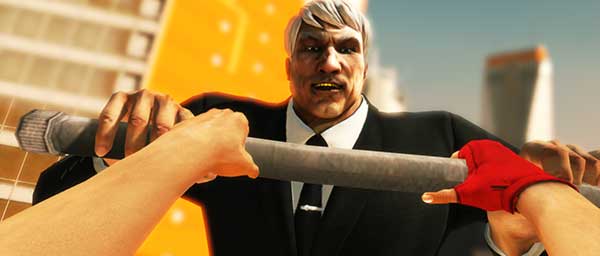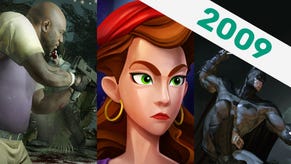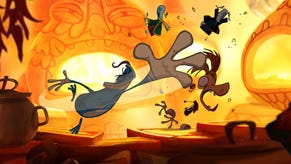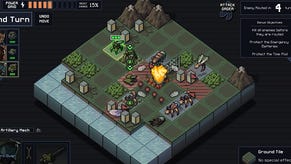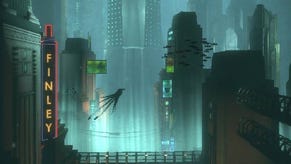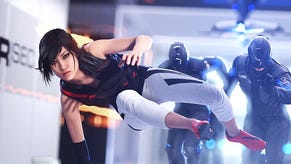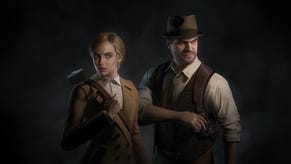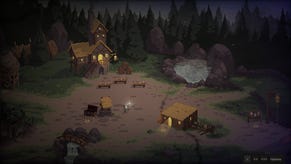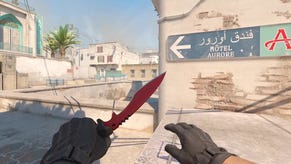Wot I Think: Mirror's Edge
Here comes an awkward metaphor: Mirror’s Edge (the delayed PC version of which was finally released last week) is hiding in the closet. Unsurprisingly, this only makes life difficult for it. For every moment it pretends to be an FPS, it feels wrong, and to any onlooker it’s visibly uncomfortable in this assumed role. If only it would cast off this sham and reveal its true colours – well, then we’d have a game proud of itself. Mirror’s Edge is a racing game, but it doesn’t have the courage to admit it. Be proud, ME. Tell the world what you are, cry it from those rooftops you spend so much time gallivanting across: “I AM A RACING GAME!”
But it doesn’t, and it’s a coward for it. Certainly, it’s not the game we hoped it would be from those early shots of a vast, alabaster cityscape. For all the alluring Le Parkour theme, that white world of rooftops isn’t yours to explore. Instead, you have a course – a circuit you have to follow with relative exactitude. There’s some give and take and a few canny shortcuts, but really you’re always headed in one direction. While that makes for a broken dream or two, it’s not inherently a problem: this is, after all, supposed to be a game about movement, fluidity and speed rather than about exploration.
Except it’s not that, either. Or at least it’s not that in the mode everyone will gravitate to – the story mode. Story mode isn’t very good. More critically, the reliance on as overbearing a narrative as Mirror’s Edge is yoked to actively distracts from what the game does very well, which is the mechanics of fluid roof-running. With the constant carrot of new plot points dangled in front of you, whenever you miss a jump or make a lousy landing, you fail the game. The flow’s disrupted and you’re faced with the annoyance of repetition (for this uses a fairly inconsiderately-implemented checkpoint save system) if you want to progress. That’s close enough to the standard system for any FPS, of course, but it’s different here - because Mirror’s Edge is a racing game.
While we do, to some extent, play racing games to progress, largely we’re playing to test ourselves, to better our own records and achievements. If you played a racing game because you wanted to reach the next between-race cutscene, screwing up would be annoying – it means you have to tackle that race again. If, though, you’re racing to achieve a best time or a shiny medal, screwing up means you’ve failed yourself as opposed to the game. You try again because you want to do better, not because you have to.
That’s why Mirror’s Edge story mode fails. Death, usually by falling but sometimes by bullets in the face, comes often. Death systems, in other words, we’re accustomed to from action-orientated genres. Perhaps ME deserves accolades for attempting something of a genre fusion, but if it had discarded its fairly insipid efforts to be an action game its challenges would be thrilling challenges of its players own ability, not challenges laid by arbitrary setpieces. That the story is not an interesting one, hung around thinly-sketched characters and a weirdly unspecific dystopic tomorrow, is almost irrelevant. This isn’t a game that should have a story – or if it did, no more of one than a Tony Hawk or SSX game. Fantasy sporting challenges contained by only the loosest structure: that’s what Mirror’s Edge should be.
Instead, it makes exactly the mistakes we all predicted it would when we first heard about it. It’s restrictive, it doesn’t allow for much thinking on your feet, the combat feels out of place and grows in importance far too much, it hinges around Tomb Raider deaths and it lacks the variety you’d expect from a singleplayer FPS. Mistakes so obvious that it’s almost astounding they’re there. Storyline mode has one thing going for it: it’s very short. You’ll blow through it in a weekend, easy.
Yet, once all the storyline guff and the associated uncomfortable compromises are pushed aside, there’s something sparkling and beautiful hiding. Mirror’s Edge has a time trial mode, one that’s been overlooked in all the pre-release blather about tie-in comics and whether Faith’s hot or not. It’s easy to overlook it, especially if you’ve already sampled and been disheartened by the story mode – you’ll presume it’s just cheerless repetition of levels you’ve already died a few too many dozen times on. Don’t do that. Play the tutorial, then leave the Story alone and come back to the Time Trials. It’s where Mirror’s Edge has the confidence to be what it really is – a racing game, but with legs not wheels, hands not gears.
The courses are still prescribed and that means your attention still won't stay with them for long, but by placing visible checkpoints scattered sequentially across those beautifully bare rooftops rather than claustrophobically ushering you from setpiece puzzle to setpiece puzzle, there’s more scope for shortcutting and for adapting to an error. You’re chasing a high score, both one set by the game and one set by unseen other players, and to achieve that you trial-and-error establish the best possible route you can devise. When you fail or fall short of your goal, it’s a drive to try again, to improve yourself, which that forlorn narrative mode just can’t muster. It’s doing something similar to The Club, but with a more appealing, logical key mechanic, and with far more character thanks to that stark, serene visual style.
Faith, you see, doesn’t matter a jot – sure, she’s a vaguely successful attempt to create an iconic character and thus launch a franchise, but the game's real character is the city skyline. Forever giddying in its scale and beautiful in that signature sterile way, the reason for it being so and whatever tale is supposed to be gripping the streets below seems so irrelevant. It’s a fantasy obstacle course. For every second that Mirror’s Edge loses sight of that, it fails. When it’s just you, the rooftops and Faith’s slim repertoire of jumps, shimmies, slides and rolls, it’s something like the urban Tarzan game we all hoped Mirror's Edge would be. Time Trial mode rewards practice and it rewards perseverance, and it's the only reason to buy Mirror's Edge.
